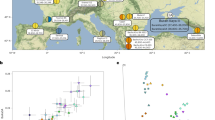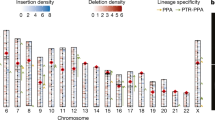Abstract
We present a high-quality genome sequence of a Neanderthal woman from Siberia. We show that her parents were related at the level of half-siblings and that mating among close relatives was common among her recent ancestors. We also sequenced the genome of a Neanderthal from the Caucasus to low coverage. An analysis of the relationships and population history of available archaic genomes and 25 present-day human genomes shows that several gene flow events occurred among Neanderthals, Denisovans and early modern humans, possibly including gene flow into Denisovans from an unknown archaic group. Thus, interbreeding, albeit of low magnitude, occurred among many hominin groups in the Late Pleistocene. In addition, the high-quality Neanderthal genome allows us to establish a definitive list of substitutions that became fixed in modern humans after their separation from the ancestors of Neanderthals and Denisovans.
This is a preview of subscription content, access via your institution
Access options
Subscribe to this journal
Receive 51 print issues and online access
$199.00 per year
only $3.90 per issue
Buy this article
- Purchase on Springer Link
- Instant access to full article PDF
Prices may be subject to local taxes which are calculated during checkout








Similar content being viewed by others
Accession codes
Accessions
European Nucleotide Archive
Data deposits
All sequence data have been submitted to the European Nucleotide Archive (ENA) and are available under the following accessions: Altai Neanderthal: ERP002097, Mezmaiskaya Neanderthal: ERP002447. The data from the 25 present-day human genomes and 13 experimentally phased present-day genomes are available as a public dataset from http://aws.amazon.com/datasets/ and from http://cdna.eva.mpg.de/neandertal/altai/.
References
Meyer, M. et al. A high-coverage genome sequence from an archaic Denisovan individual. Science 338, 222–226 (2012)
Reich, D. et al. Genetic history of an archaic hominin group from Denisova Cave in Siberia. Nature 468, 1053–1060 (2010)
Mednikova, M. B. A proximal pedal phalanx of a paleolithic hominin from Denisova cave, Altai. Archaeol. Ethnol. Anthropol. Eurasia 39, 129–138 (2011)
Green, R. E. et al. A complete Neandertal mitochondrial genome sequence determined by high-throughput sequencing. Cell 134, 416–426 (2008)
Briggs, A. W. et al. Targeted retrieval and analysis of five Neandertal mtDNA genomes. Science 325, 318–321 (2009)
Golovanova, L. V., Hoffecker, J. F., Kharitonov, V. M. & Romanova, G. P. Mezmaiskaya cave: A Neanderthal occupation in the Northern Caucasus. Curr. Anthropol. 40, 77–86 (1999)
Gansauge, M. T. & Meyer, M. Single-stranded DNA library preparation for the sequencing of ancient or damaged DNA. Nature Protocols 8, 737–748 (2013)
Kircher, M. Analysis of high-throughput ancient DNA sequencing data. Methods Mol. Biol. 840, 197–228 (2012)
Briggs, A. W. et al. Patterns of damage in genomic DNA sequences from a Neandertal. Proc. Natl Acad. Sci. USA 104, 14616–14621 (2007)
Briggs, A. W. et al. Removal of deaminated cytosines and detection of in vivo methylation in ancient DNA. Nucleic Acids Res. 38, e87 (2010)
Hofreiter, M., Jaenicke, V., Serre, D., von Haeseler, A. & Paabo, S. DNA sequences from multiple amplifications reveal artifacts induced by cytosine deamination in ancient DNA. Nucleic Acids Res. 29, 4793–4799 (2001)
Green, R. E. et al. A draft sequence of the Neandertal genome. Science 328, 710–722 (2010)
Skinner, A. R. et al. ESR dating at Mezmaiskaya Cave, Russia. Appl. Radiat. Isot. 62, 219–224 (2005)
Kitzman, J. O. et al. Haplotype-resolved genome sequencing of a Gujarati Indian individual. Nature Biotechnol. 29, 59–63 (2011)
Abecasis, G. R. et al. A map of human genome variation from population-scale sequencing. Nature 467, 1061–1073 (2010)
Awadalla, P. et al. Direct measure of the de novo mutation rate in autism and schizophrenia cohorts. Am. J. Hum. Genet. 87, 316–324 (2010)
Roach, J. C. et al. Analysis of genetic inheritance in a family quartet by whole-genome sequencing. Science 328, 636–639 (2010)
Kong, A. et al. Rate of de novo mutations and the importance of father’s age to disease risk. Nature 488, 471–475 (2012)
Campbell, C. D. et al. Estimating the human mutation rate using autozygosity in a founder population. Nature Genet. 44, 1277–1281 (2012)
Li, H. & Durbin, R. Inference of human population history from individual whole-genome sequences. Nature 475, 493–496 (2011)
Prado-Martinez, J. et al. Great ape genetic diversity and population history. Nature 499, 471–475 (2013)
Kirin, M. et al. Genomic runs of homozygosity record population history and consanguinity. PLoS ONE 5, e13996 (2010)
Leffler, E. M. et al. Revisiting an old riddle: what determines genetic diversity levels within species? PLoS Biol. 10, e1001388 (2012)
Reich, D. et al. Denisova admixture and the first modern human dispersals into Southeast Asia and Oceania. Am. J. Hum. Genet. 89, 516–528 (2011)
Skoglund, P. & Jakobsson, M. Archaic human ancestry in East Asia. Proc. Natl Acad. Sci. USA 108, 18301–18306 (2011)
Fu, Q. et al. DNA analysis of an early modern human from Tianyuan Cave, China. Proc. Natl Acad. Sci. USA 110, 2223–2227 (2013)
Wall, J. D. et al. Higher levels of Neanderthal ancestry in East Asians than in Europeans. Genetics 194, 199–209 (2013)
Abi-Rached, L. et al. The shaping of modern human immune systems by multiregional admixture with archaic humans. Science 334, 89–94 (2011)
Waddell, P. J. & Tan, X. New g%AIC, g%AICc, g%BIC, and power divergence fit statistics expose mating between modern humans, Neanderthals and other archaics. Preprint at http://arxiv.org/abs/1212.6820 (2012)
Wegmann, D., Leuenberger, C., Neuenschwander, S. & Excoffier, L. ABCtoolbox: a versatile toolkit for approximate Bayesian computations. BMC Bioinformatics 11, 116 (2010)
Kumar, R. A. et al. Recurrent 16p11.2 microdeletions in autism. Hum. Mol. Genet. 17, 628–638 (2008)
Abecasis, G. R. et al. An integrated map of genetic variation from 1,092 human genomes. Nature 491, 56–65 (2012)
Fietz, S. A. & Huttner, W. B. Cortical progenitor expansion, self-renewal and neurogenesis-a polarized perspective. Curr. Opin. Neurobiol. 21, 23–35 (2011)
Kokovay, E. et al. VCAM1 is essential to maintain the structure of the SVZ niche and acts as an environmental sensor to regulate SVZ lineage progression. Cell Stem Cell 11, 220–230 (2012)
Wang, C., Liang, C. C., Bian, Z. C., Zhu, Y. & Guan, J. L. FIP200 is required for maintenance and differentiation of postnatal neural stem cells. Nature Neurosci. 16, 532–542 (2013)
Rios, D. et al. A database and API for variation, dense genotyping and resequencing data. BMC Bioinformatics 11, 238 (2010)
Hublin, J. J. Out of Africa: modern human origins special feature: the origin of Neandertals. Proc. Natl Acad. Sci. USA 106, 16022–16027 (2009)
Sankararaman, S., Patterson, N., Li, H., Pääbo, S. & Reich, D. The date of interbreeding between Neandertals and modern humans. PLoS Genet. 8, e1002947 (2012)
Yang, M. A., Malaspinas, A. S., Durand, E. Y. & Slatkin, M. Ancient structure in Africa unlikely to explain Neanderthal and non-African genetic similarity. Mol. Biol. Evol. 29, 2987–2995 (2012)
Eriksson, A. & Manica, A. Effect of ancient population structure on the degree of polymorphism shared between modern human populations and ancient hominins. Proc. Natl Acad. Sci. USA 109, 13956–13960 (2012)
Krause, J. et al. The complete mitochondrial DNA genome of an unknown hominin from southern Siberia. Nature 464, 894–897 (2010)
Gabunia, L. et al. Dmanisi and dispersal. Evol. Anthropol. 10, 158–170 (2001)
Asfaw, B. et al. Remains of Homo erectus from Bouri, Middle Awash, Ethiopia. Nature 416, 317–320 (2002)
Kircher, M., Stenzel, U. & Kelso, J. Improved base calling for the Illumina Genome Analyzer using machine learning strategies. Genome Biol. 10, R83 (2009)
Langergraber, K. E. et al. Generation times in wild chimpanzees and gorillas suggest earlier divergence times in great ape and human evolution. Proc. Natl Acad. Sci. USA 109, 15716–15721 (2012)
Scally, A. & Durbin, R. Revising the human mutation rate: implications for understanding human evolution. Nature Rev. Genet. 13, 745–753 (2012)
Acknowledgements
We thank M. Hammer, C. Winkler and W. Klitz for sharing DNA samples; W. Huttner and his group, B. Peter, J. G. Schraiber and M. A. Yang for helpful discussions; and A. Lewis and R. Qiu for technical assistance. N.P. and D.R. are grateful for the chance to discuss these results with Peter Waddell who independently found evidence of a deeply diverged hominin admixing into the Denisova genome. D.R. and E.E.E. are Howard Hughes Medical Institute Investigators. D.R. and N.P. were supported by NSF grant number 1032255 and NIH grant GM100233; E.E.E. by NIH grant HG002385; J.S. by grant HG006283 from the National Genome Research Institute (NHGRI); S.S. by a post-doctoral fellowship from the Harvard University Science of the Human Past Program; F.J. and M.S. in part by a grant from the NIH (R01-GM40282); P.H.S. by an HHMI International Student Fellowship. We thank the team at the NIH Intramural Sequencing Center and Alice Young in particular, for generating some of the sequence reported here. This research was supported in part by the Paul G. Allen Family Foundation. Major funding support came from the Presidential Innovation Fund of the Max Planck Society.
Author information
Authors and Affiliations
Contributions
S.Saw., A.H. and Q.F. performed the experiments; K.P., F.R., N.P., F.J., S.San., S.Saw., A.H., G.R., P.H.S., C.d.F., M.D., Q.F., M.Ki., M.Ku., M.L., M.M., M.O., M.Si., C.T., H.L., S.M., A.T., P.M., J.P., J.C.M., S.H.V., R.E.G., I.H., P.L.F.J., J.O.K., J.S., E.E.E., E.S.L., T.E.B., M.Sl., D.R., J.K., and S.P. analysed genetic data; L.V.G., V.B.D., M.V.S., A.P.D. and B.V. analysed archaeological and anthropological data; H.B. and H.C. provided samples and reagents; K.P., J.K. and S.P. wrote and edited the manuscript with input from all authors.
Corresponding authors
Ethics declarations
Competing interests
The authors declare no competing financial interests.
Extended data figures and tables
Extended Data Figure 1 Heterozygosity estimates for the Altai Neanderthal individual, the Denisovan individual, non-Africans and Africans.
The bars for the latter two give the range of heterozygosity observed among 15 non-African and 10 African individuals, respectively (Supplementary Information section 9).
Extended Data Figure 2 Neanderthal-introgressed loci in Denisova.
Divergence of the Altai Neanderthal to the most closely related Denisovan haplotype in windows of at least 200 kb on chromosome 6. Divergence is given as percentage of human–chimpanzee divergence and bars represent ± 1 standard error.
Supplementary information
Supplementary Information
This file contains Supplementary Text, Tables and Figures – see contents page for details. (PDF 16537 kb)
Rights and permissions
About this article
Cite this article
Prüfer, K., Racimo, F., Patterson, N. et al. The complete genome sequence of a Neanderthal from the Altai Mountains. Nature 505, 43–49 (2014). https://doi.org/10.1038/nature12886
Received:
Accepted:
Published:
Issue Date:
DOI: https://doi.org/10.1038/nature12886
This article is cited by
-
More than a decade of genetic research on the Denisovans
Nature Reviews Genetics (2024)
-
The Allen Ancient DNA Resource (AADR) a curated compendium of ancient human genomes
Scientific Data (2024)
-
Us and Them: How to Reconcile Archaeological and Biological Data at the Middle-to-Upper Palaeolithic Transition in Europe?
Journal of Paleolithic Archaeology (2024)
-
KIN: a method to infer relatedness from low-coverage ancient DNA
Genome Biology (2023)
-
Evolutionary relevance of single nucleotide variants within the forebrain exclusive human accelerated enhancer regions
BMC Molecular and Cell Biology (2023)
Comments
By submitting a comment you agree to abide by our Terms and Community Guidelines. If you find something abusive or that does not comply with our terms or guidelines please flag it as inappropriate.



